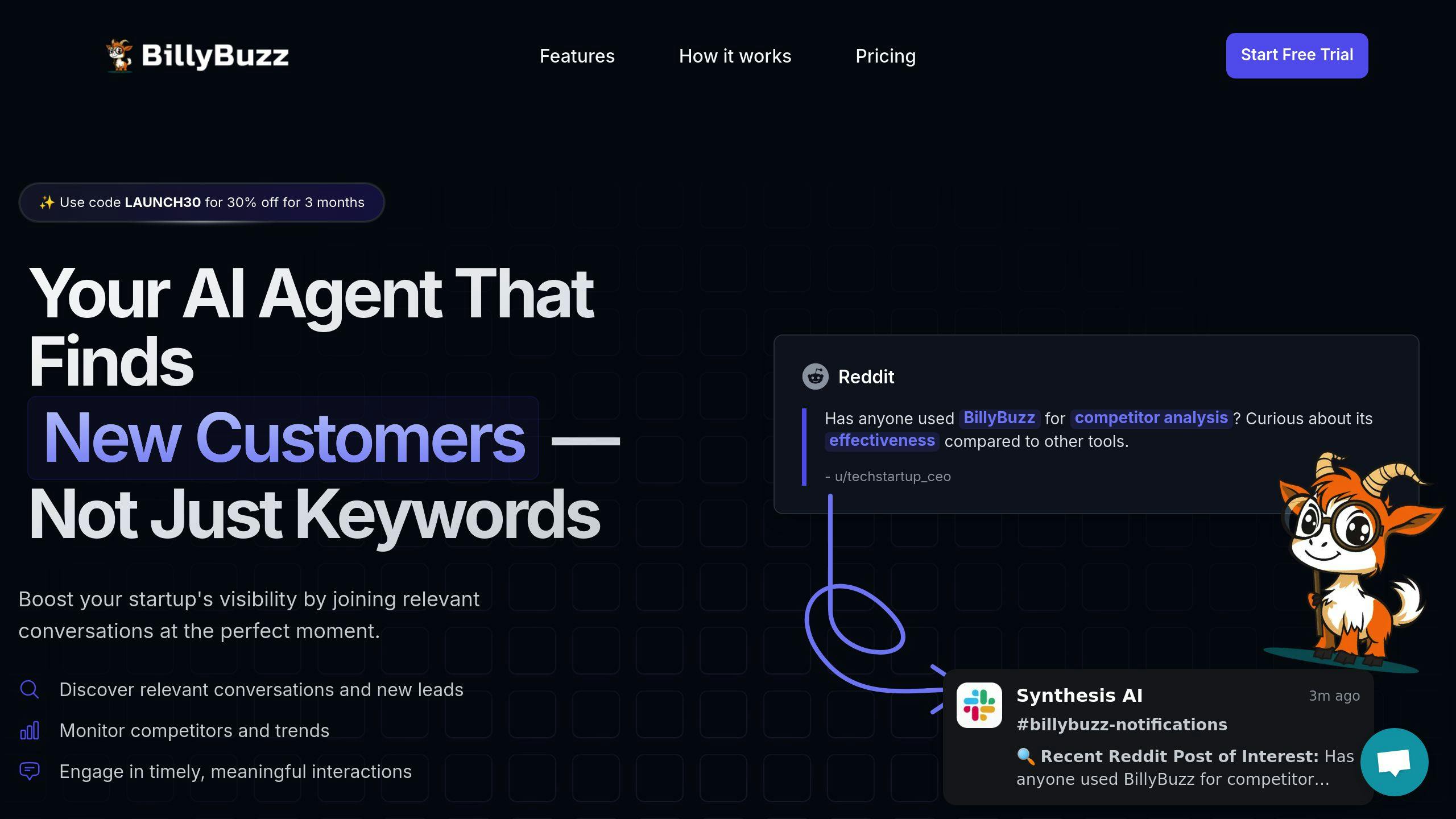
Why Real-Time Engagement is Crucial for Startup Success
Real-time engagement means interacting with your customers instantly, whether through live chat, social media, or personalized responses. Startups that adopt this approach see faster issue resolution, improved customer satisfaction, and higher conversion rates. For example, live chat can reduce resolution times by 50%, while real-time personalization can boost conversions by 30%.
Key Benefits of Real-Time Engagement:
- Build Trust: Immediate responses show reliability.
- Enhance User Experience: Faster support leads to happier customers.
- Gain a Competitive Edge: Stand out by acting on instant feedback.
Startups can use tools like BillyBuzz for AI-powered social monitoring, Hootsuite for managing multiple channels, and sentiment analysis tools like Brand24 to track public opinion. By combining these tools with scalable strategies, startups can grow efficiently while maintaining meaningful customer connections.
Advantages of Real-Time Engagement for Startups
Building Customer Trust and Loyalty
Real-time engagement helps startups strengthen customer loyalty. Research from SuperOffice shows that live chat interactions achieve an impressive 92% customer satisfaction rate [1]. Quick, reliable communication builds trust and encourages customers to stay connected with your brand.
But it’s not just about trust - real-time engagement also shapes how customers feel about your brand, creating a better overall experience.
Improving User Experience
Instant responses and personalized support significantly improve how users interact with your business. For example, a fintech startup using live chat cut resolution times by 50%, increased satisfaction scores, and saw better user retention [1]. These fast, tailored interactions leave a lasting impression on customers.
Gaining a Competitive Advantage
In a fast-moving market, real-time engagement can set startups apart. Here’s how it impacts business:
| Benefit | Business Impact |
|---|---|
| Faster Response Times | Happier customers and lower churn rates |
| Real-Time Analytics | Smarter decisions based on instant feedback |
| Personalized Interactions | Better conversion rates and stronger customer loyalty |
| Streamlined Operations | Lower costs and better service delivery |
Gaming startups, for instance, use live-streamed tournaments to engage their audience directly, creating active communities and standing out from traditional platforms [2]. These efforts often lead to stronger customer satisfaction, more word-of-mouth referrals, and organic growth. For startups with tight budgets, this type of growth can lower customer acquisition costs while building a solid market presence.
"Real-time engagement isn't just about being responsive - it's about creating meaningful interactions that drive business growth. When startups can provide immediate value to their customers, they naturally pull ahead of the competition." [2]
These benefits highlight the need for startups to choose the right tools to make real-time engagement work effectively.
Customer engagement strategies for online businesses
Tools for Real-Time Engagement
To make the most of real-time engagement - like building trust, improving user experience, and staying ahead of competitors - startups need the right tools. These tools help monitor and connect with customers instantly, creating stronger relationships and driving growth.
BillyBuzz: AI-Powered Social Monitoring

BillyBuzz uses AI to go beyond basic keyword tracking. It analyzes customer conversations in detail, offering startups insights that matter most. The platform highlights the most relevant discussions for your business, making it easier to engage meaningfully on social media.
It also offers pricing plans designed for startups at all stages, from budget-friendly options for beginners to advanced features for growing businesses.
Hootsuite and Sprout Social

Hootsuite and Sprout Social are all-in-one platforms for managing social media. They let startups monitor multiple networks from a single dashboard. Sprout Social’s Smart Inbox stands out by pulling all social messages into one stream, so you can respond quickly and keep engagement consistent.
Social Listening Tools for Sentiment Analysis
Tools like Brand24 and Meltwater are ideal for tracking how people feel about your brand. They provide real-time sentiment analysis, alert you to potential crises, and offer insights on competitors. Meltwater, for example, scans large volumes of online conversations to give you a clear view of public perception.
Key features of these tools include:
- Real-time tracking of brand mentions across social platforms, blogs, and forums
- Sentiment analysis to measure public opinion and emotional reactions
- Crisis alerts to notify you of sudden spikes in negative feedback
- Competitive insights to monitor trends and track rival activity
With these tools, startups can focus on creating strategies that boost engagement, strengthen loyalty, and support growth.
sbb-itb-efb8de3
Implementing Real-Time Engagement Strategies
Once you have the right tools, the next step is to put strategies into action that can help drive your startup's growth.
Using Event-Driven Engagement
Event-driven engagement means responding quickly to specific user actions, like browsing a product or leaving items in a cart, with personalized and timely follow-ups. For example, when users interact with your platform, you could send them product guides or exclusive offers. Tools like BillyBuzz make it possible to respond to these interactions within 15 minutes, which is perfect for handling time-sensitive inquiries.
Monitoring and Engaging in Conversations
Real-time monitoring of conversations involves spotting important discussions and jumping in with relevant insights. Social listening tools can help startups stay on top of these conversations. Here's how:
- Track brand mentions, product names, and industry-specific keywords to identify key discussions. Focus on responding to urgent or highly active ones.
- Keep your tone consistent. A friendly and helpful brand voice goes a long way on any platform.
Instead of just pushing out messages, aim to participate in meaningful conversations across different platforms.
Scaling Engagement as the Startup Grows
As your startup grows, you’ll need systems that can scale while still delivering quality interactions. Striking the right balance between automation and personal touch is key.
| Growth Stage | Engagement Focus | Automation Level |
|---|---|---|
| Early Stage | Build personal connections | Minimal automation |
| Growth Phase | Combine automation and human touch | Moderate automation |
| Scale Phase | Use AI with human oversight | High automation |
Start by automating simple, repetitive tasks, but keep human interaction for more complex or sensitive issues. Tools like Hootsuite's Smart Inbox can help you manage higher message volumes while still providing quick and thoughtful responses.
Case Studies: Startups Using Real-Time Engagement
These examples show how startups have used real-time engagement tactics, paired with the right tools, to achieve measurable results.
Startup A: Leveraging AI for Lead Generation
In 2024, fintech startup PayQuick showcased how AI-driven tools can transform lead generation. By integrating BillyBuzz into their marketing operations, they tracked conversations about digital payments and cryptocurrency across subreddits. Within just three months, they cut resolution times by 50%, boosted qualified leads by 35%, and improved customer satisfaction by 40%. This was made possible through automated prioritization of key conversations and quicker team responses.
PayQuick's marketing team used BillyBuzz to monitor 10 fintech-related subreddits with automated alerts. The results speak for themselves:
| Metric | Before BillyBuzz | After BillyBuzz |
|---|---|---|
| Daily Lead Generation | 25 leads | 85 leads |
| Customer Satisfaction | 72% | 89% |
Startup B: Real-Time Social Media Engagement
EcoBox, a startup specializing in eco-friendly packaging, revamped their customer engagement by using Hootsuite's Smart Inbox feature. Their strategy emphasized real-time responses and personalized interactions across social media.
Starting in September 2024, EcoBox monitored brand mentions, responded to queries within 30 minutes, and used sentiment analysis to address negative feedback before it escalated. This proactive approach led to impressive growth:
| Engagement Metric | Q3 2024 | Q4 2024 | Growth |
|---|---|---|---|
| Response Rate | 65% | 95% | +46% |
| Customer Interactions | 1,200 | 3,600 | +200% |
| Brand Mentions | 500 | 2,000 | +300% |
By increasing customer interactions by 200% and brand mentions by 300%, EcoBox significantly boosted their market visibility. Their success highlights the power of quick response times and effective social media monitoring.
These examples illustrate how startups can use real-time engagement strategies to drive growth and improve customer connections.
Conclusion: The Future of Real-Time Engagement for Startups
Real-time engagement plays a key role in driving growth for startups. Companies like PayQuick and EcoBox show how immediate interactions with customers can directly boost business performance. As we approach 2025, tools powered by AI are evolving rapidly, helping startups manage and scale these interactions more efficiently.
The success of PayQuick and EcoBox highlights how using real-time engagement tools improves metrics like resolution times, customer satisfaction, and conversion rates. These examples underscore the value of combining smart technology with human understanding to create effective engagement strategies.
Here are some strategies startups can use to make the most of real-time engagement:
- Leverage AI for Monitoring and Responses: Use platforms like BillyBuzz or Hootsuite to track interactions across multiple channels. Automate repetitive tasks while keeping responses personal, and use sentiment analysis to quickly address customer concerns.
- Track and Refine Performance: Keep an eye on key metrics such as satisfaction scores, resolution times, and conversion rates. Analyze engagement trends to adjust and improve strategies over time.
- Plan for Scalable Growth: Adopt systems that can handle growth without compromising quality. Strike the right balance between automation and human interaction, ensuring consistent response times across all platforms.
The future of real-time engagement lies in blending AI with human insight to deliver fast and meaningful interactions. By applying these strategies and learning from examples like PayQuick and EcoBox, startups can strengthen customer relationships and achieve long-term success [1][2][3][4].
